Shared Micromobility: Between Physical and Digital Reality
Abstract
:1. Introduction
1.1. Combining the Digital, Social and Physical Space through the Example of Shared Micromobility
1.2. The Social Dimension of Shared Micromobility
2. Materials and Methods
3. Results
3.1. The History of Sharing Bicycles and Scooters in St. Petersburg
3.2. Shared Micromobility in the Minds of Petersburgers
4. Discussion
Author Contributions
Funding
Institutional Review Board Statement
Informed Consent Statement
Data Availability Statement
Conflicts of Interest
Appendix A
| Judgment Issues (Bike) | Mean Observation | Judgment Issues (Scooter) | Mean Observation | |
|---|---|---|---|---|
| Micro-vehicle experience (riding of Micro-vehicle) | 6.9 | 6.68 | ||
| Satisfaction with user experience | 7.15 | 7.2 | ||
| Bike-sharing is fun | 7.2 | Scooter-sharing is fun | 7.3 | |
| I believe that bike-sharing is useful | 7.3 | I believe that scooter-sharing is useful | 7.2 | |
| Bike-sharing is a pleasure | 7.3 | Scooter-sharing is a pleasure | 7.4 | |
| Bike-sharing is exciting | 6.8 | Scooter-sharing is exciting | 7.0 | |
| Trust Attitude | 6.85 | 6.85 | ||
| Based on my own experience with bike-sharing, I know it is a reliable system | 6.9 | Based on my own experience with scooters, I know it meets the expectations of the users | 6.8 | |
| Based on my own bike-sharing experience, I know this system is harmless | 6.8 | Based on my own scooter-sharing experience, I know this system is harmless | 6.9 | |
| Personal Accomplishment | 6.8 | 6.05 | ||
| I am glad when I see how much I have cycled | 6.8 | I am glad when I see how much I have ridden on the scooter | 6.2 | |
| I feel energized when I see calories burned | 6.8 | I feel energized when I see calories burned | 5.9 | |
| Perceived Usefulness | 6.9 | 6.9 | ||
| Bike-sharing helps me | 6.9 | Scooter-sharing helps me | 6.9 | |
| Bike-sharing can make my journeys more comfortable | 7.1 | Scooter-sharing can make my journeys more comfortable | 7.1 | |
| Bike-sharing can make my journeys more efficient | 7.0 | Scooter-sharing can make my journeys more efficient | 7.1 | |
| I believe that bike-sharing is practical | 7.1 | I believe that scooter-sharing is practical | 7.0 | |
| I believe bike-sharing is good for my daily commute | 6.5 | I believe scooter-sharing is good for my daily commute | 6.6 | |
| Subjective Well-Being | 6.8 | 6.4 | ||
| My bike-sharing experience was memorable—it made my life easier | 6.7 | My scooter-sharing experience was memorable—it made my life easier | 6.6 | |
| In general, shortly after riding the shared bike, I felt good | 7.1 | In general, shortly after riding the shared scooter, I felt good | 6.7 | |
| After using bike sharing, I felt like my life had become more complete | 6.6 | After using scooter sharing, I felt like my life had become more complete | 5.9 | |
| Social environment | 6 | 5.68 | ||
| Influence of public opinion | 6.1 | 5.43 | ||
| When I rent a bike, I look better in the eyes of others | 6.0 | When I rent a scooter, I look better in the eyes of others | 5.2 | |
| Using bike sharing gives me social approval | 6.3 | Using scooter sharing gives me social approval | 5.4 | |
| The fact that I rent a bike makes a good impression on those around me | 6.0 | The fact that I rent a scooter makes a good impression on those around me | 5.7 | |
| Influence of the reference group | 5.86 | 5.56 | ||
| Most of the people who are important to me think that I should use bike-sharing | 5.8 | Most of the people who are important to me think that I should use scooter-sharing | 5.5 | |
| Most of the people who are important to me think that cycling is a good idea | 5.8 | Most of the people who are important to me think that riding a scooter is a good idea | 5.5 | |
| Most of the people who influence my decisions think that I should use bike sharing | 6.0 | Most of the people who influence my decisions think that I should use scooter sharing | 5.7 | |
| Impact on the immediate environment | 6.06 | 6.06 | ||
| I have often recommended bike sharing to my family and friends | 6.3 | I have often recommended scooter sharing to my family and friends | 6.2 | |
| I often use bike-sharing as a way to relax with my family and friends | 6.0 | I often use scooter-sharing as a way to relax with my family and friends | 6.3 | |
| My friends and family started using bike-sharing on my advice | 5.9 | My friends and family started using scooter-sharing on my advice | 5.7 | |
| Perception of micromobility | 6.77 | 6.86 | ||
| Injury risk | 6.2 | 6.6 | ||
| Inexperienced people using bike-sharing can get hurt | 6.0 | Inexperienced people using scooter-sharing can get hurt | 6.0 | |
| Because of the small number of cycle lanes, a cyclist can be the culprit in sidewalk accidents | 6.6 | Because of the small number of scooter lanes, a scooter-user can be the culprit in sidewalk accidents | 7.0 | |
| Inexperienced bike-sharing users can injure others | 6.0 | Inexperienced scooter-sharing users can injure others | 6.8 | |
| Environmental friendliness | 6.86 | 6.56 | ||
| I use bike-sharing because a bike is an environmentally friendly mode of transport | 6.8 | I use scooter-sharing because a scooter is an environmentally friendly mode of transport | 6.5 | |
| The more people use bike-sharing, the less we pollute the environment | 7.1 | The more people use scooter-sharing, the less we pollute the environment | 6.8 | |
| I advise my friends and family to use bike-sharing whenever possible, as bicycles are environmentally friendly | 6.7 | I advise my friends and family to use a scooter-sharing whenever possible, as the scooter is environmentally friendly | 6.4 | |
| Convenience of the digital environment | 7.0 | 7.06 | ||
| I like that bicycles are equipped with GPS modules | 7.0 | I like that scooters are equipped with GPS modules | 6.7 | |
| I like that I can see the nearest bike-sharing station in the mobile app | 7.3 | I like that I can see the nearest scooter-sharing station in the mobile app | 7.5 | |
| I never had a problem getting my bike to the station | 6.7 | I never had a problem getting my scooter to the station | 7.0 | |
| Perceived Ease of Use | 7.03 | 7.23 | ||
| I can easily and simply interact with the bike sharing information system | 7 | I can easily and simply interact with the scooter sharing information system | 7.3 | |
| Bike-sharing is easy for me | 7.0 | Scooter-sharing is easy for me | 7.2 | |
| I can easily and simply interact with bike sharing services | 7.1 | I can easily and simply interact with scooter sharing services | 7.2 |
References
- Pozdeeva, E.; Shipunova, O.; Popova, N.; Evseev, V.; Evseeva, L.; Romanenko, I.; Mureyko, L. Assessment of Online Environment and Digital Footprint Functions in Higher Education Analytics. Educ. Sci. 2021, 11, 256. [Google Scholar] [CrossRef]
- Pokrovskaia, N.N.; Tyulin, A.T. Psychological Features of the Regulative Mechanisms Emerging in the Digital Space. Technol. Lang. 2021, 2, 106–125. [Google Scholar] [CrossRef]
- Kalantzis-Cope, P.; Gherab-Martín, K. Emerging Digital Spaces in Contemporary Society; Palgrave Macmillan: London, UK, 2010; ISBN 978-1-349-32397-5. [Google Scholar]
- Kramsch, C. The Political Power of the Algorithm. Technol. Lang. 2020, 1, 45–48. [Google Scholar] [CrossRef]
- Tretyakov, I.L. Information Networks and Manipulative Technologies in the Arsenal of Extremists. In Knowledge in the Information Society; Bylieva, D., Nordmann, A., Shipunova, O., Volkova, V., Eds.; PCSF 2020, CSIS 2020, Lecture Notes in Networks and Systems; Springer: Cham, Switzerland, 2021; Volume 184, pp. 125–135. [Google Scholar]
- Pokrovskaia, N.N.; Leontyeva, V.L.; Ababkova, M.Y.; Cappelli, L.; D’Ascenzo, F. Digital Communication Tools and Knowledge Creation Processes for Enriched Intellectual Outcome—Experience of Short-Term E-Learning Courses during Pandemic. Future Internet 2021, 13, 43. [Google Scholar] [CrossRef]
- Pokrovskaia, N.N.; Leontyeva, V.L.; Ababkova, M.Y.; D’Ascenzo, F. Regulation of Digital Behavior Models for Knowledge Transfer: Organizational Concerns of Remote Learning. Educ. Sci. 2021, 11, 592. [Google Scholar] [CrossRef]
- Samorodova, E.A.; Belyaeva, I.G.; Bakaeva, S.A. Analysis of communicative methods effectiveness in teaching foreign languages during the coronavirus epidemic: Distance format. XLinguae 2021, 14, 131–140. [Google Scholar] [CrossRef]
- Sumalee, A.; Ho, H.W. Smarter and more connected: Future intelligent transportation system. IATSS Res. 2018, 42, 67–71. [Google Scholar] [CrossRef]
- Temirgalieva, L.M.; Pustokhin, D.A.; Pustokhina, I.V. Development of Moscow Transport System. J. Crit. Rev. 2020, 7, 1903–1907. [Google Scholar]
- Tandon, S.; Subramanian, K.; Tambi, H.; Samiappan, D. Advancement in Transportation and Traffic Light Monitoring System. In Cognitive Informatics and Soft Computing; Advances in Intelligent Systems and Computing; Springer: Singapore, 2019; Volume 768, pp. 409–420. [Google Scholar]
- Choosakun, A.; Chaiittipornwong, Y.; Yeom, C. Development of the Cooperative Intelligent Transport System in Thailand: A Prospective Approach. Infrastructures 2021, 6, 36. [Google Scholar] [CrossRef]
- Kchaou, A.; Abassi, R.; El Fatmi, S.G. Toward a Security Scheme for an Intelligent Transport System. In Research Anthology on Blockchain Technology in Business, Healthcare, Education, and Government; IGI Global: Hershey, PA, USA, 2021; pp. 884–896. [Google Scholar]
- Jittrapirom, P.; Caiati, V.; Feneri, A.-M.; Ebrahimigharehbaghi, S.; González, M.J.A.; Narayan, J. Mobility as a Service: A Critical Review of Definitions, Assessments of Schemes, and Key Challenges. Urban Plan. 2017, 2, 13–25. [Google Scholar] [CrossRef] [Green Version]
- Hosseinzadeh, A.; Algomaiah, M.; Kluger, R.; Li, Z. E-scooters and sustainability: Investigating the relationship between the density of E-scooter trips and characteristics of sustainable urban development. Sustain. Cities Soc. 2021, 66, 102624. [Google Scholar] [CrossRef]
- Ahvenniemi, H.; Huovila, A. How do cities promote urban sustainability and smartness? An evaluation of the city strategies of six largest Finnish cities. Environ. Dev. Sustain. 2021, 23, 4174–4200. [Google Scholar] [CrossRef]
- Sharifi, A.; Kawakubo, S.; Milovidova, A. Urban sustainability assessment tools. In Urban Systems Design; Elsevier: Amsterdam, The Netherlands, 2020; pp. 345–372. [Google Scholar]
- de la Torre, R.; Corlu, C.G.; Faulin, J.; Onggo, B.S.; Juan, A.A. Simulation, Optimization, and Machine Learning in Sustainable Transportation Systems: Models and Applications. Sustainability 2021, 13, 1551. [Google Scholar] [CrossRef]
- Lazarus, J.; Pourquier, J.C.; Feng, F.; Hammel, H.; Shaheen, S. Micromobility evolution and expansion: Understanding how docked and dockless bikesharing models complement and compete—A case study of San Francisco. J. Transp. Geogr. 2020, 84, 102620. [Google Scholar] [CrossRef]
- Raptopoulou, A.; Basbas, S.; Stamatiadis, N.; Nikiforiadis, A. A First Look at E-Scooter Users. In Advances in Mobility-as-a-Service Systems; Nathanail, E.G., Adamos, G., Karakikes, I., Eds.; CSUM 2020, Advances in Intelligent Systems and Computing; Springer: Cham, Switzerland, 2021; Volume 1278, pp. 882–891. [Google Scholar]
- Zou, Z.; Younes, H.; Erdoğan, S.; Wu, J. Exploratory Analysis of Real-Time E-Scooter Trip Data in Washington, D.C. Transp. Res. Rec. J. Transp. Res. Board 2020, 2674, 285–299. [Google Scholar] [CrossRef]
- Campisi, T.; Nahiduzzaman, K.M.; Ticali, D.; Tesoriere, G. Bivariate Analysis of the Influencing Factors of the Upcoming Personal Mobility Vehicles (PMVs) in Palermo. In Computational Science and Its Applications—ICCSA 2020; Gervasi, O., Ed.; ICCSA 2020, Lecture Notes in Computer Science; Springer: Cham, Switzerland, 2020; Volume 12250, pp. 868–881. [Google Scholar]
- Petzoldt, T.; Ringhand, M.; Anke, J.; Schekatz, N. Do German (Non)Users of E-Scooters Know the Rules (and Do They Agree with Them)? In HCI in Mobility, Transport, and Automotive Systems; Krömker, H., Ed.; HCII 2021, Lecture Notes in Computer Science; Springer: Cham, Switzerland, 2021; Volume 12791, pp. 425–435. [Google Scholar]
- Kjærup, M.; Skov, M.B.; van Berkel, N. E-Scooter Sustainability—A Clash of Needs, Perspectives, and Experiences. In Human-Computer Interaction—INTERACT 2021; Ardito, C., Ed.; INTERACT 2021, Lecture Notes in Computer Science; Springer: Cham, Switzerland, 2021; Volume 12934, pp. 365–383. [Google Scholar]
- Ma, X.; Ji, Y.; Yuan, Y.; Van Oort, N.; Jin, Y.; Hoogendoorn, S. A comparison in travel patterns and determinants of user demand between docked and dockless bike-sharing systems using multi-sourced data. Transp. Res. Part A Policy Pract. 2020, 139, 148–173. [Google Scholar] [CrossRef]
- Tuncer, S.; Laurier, E.; Brown, B.; Licoppe, C. Notes on the practices and appearances of e-scooter users in public space. J. Transp. Geogr. 2020, 85, 102702. [Google Scholar] [CrossRef]
- Krier, C.; Chrétien, J.; Lagadic, M.; Louvet, N. How Do Shared Dockless E-Scooter Services Affect Mobility Practices in Paris? A Survey-Based Estimation of Modal Shift. Transp. Res. Rec. J. Transp. Res. Board 2021, 2675, 291–304. [Google Scholar] [CrossRef]
- Haworth, N.; Schramm, A.; Twisk, D. Comparing the risky behaviours of shared and private e-scooter and bicycle riders in downtown Brisbane, Australia. Accid. Anal. Prev. 2021, 152, 105981. [Google Scholar] [CrossRef]
- Gibson, H.; Curl, A.; Thompson, L. Blurred boundaries: E-scooter riders’ and pedestrians’ experiences of sharing space. Mobilities 2021, 1–16. [Google Scholar] [CrossRef]
- Almannaa, M.H.; Alsahhaf, F.A.; Ashqar, H.I.; Elhenawy, M.; Masoud, M.; Rakotonirainy, A. Perception Analysis of E-Scooter Riders and Non-Riders in Riyadh, Saudi Arabia: Survey Outputs. Sustainability 2021, 13, 863. [Google Scholar] [CrossRef]
- Cao, Z.; Zhang, X.; Chua, K.; Yu, H.; Zhao, J. E-scooter sharing to serve short-distance transit trips: A Singapore case. Transp. Res. Part A Policy Pract. 2021, 147, 177–196. [Google Scholar] [CrossRef]
- Gao, K.; Yang, Y.; Li, A.; Li, J.; Yu, B. Quantifying economic benefits from free-floating bike-sharing systems: A trip-level inference approach and city-scale analysis. Transp. Res. Part A Policy Pract. 2021, 144, 89–103. [Google Scholar] [CrossRef]
- Kizielewicz, B.; Dobryakova, L. How to choose the optimal single-track vehicle to move in the city? Electric scooters study case. Procedia Comput. Sci. 2020, 176, 2243–2253. [Google Scholar] [CrossRef]
- Smith, C.S.; Schwieterman, J.P. E-Scooter Scenarios: Evaluating the Potential Mobility Benefits of Shared Dockless Scooters in Chicago; The National Academies of Sciences, Engineering, and Medicine: Washington, DC, USA, 2018. [Google Scholar]
- Glenn, J.; Bluth, M.; Christianson, M.; Pressley, J.; Taylor, A.; Macfarlane, G.S.; Chaney, R.A. Considering the Potential Health Impacts of Electric Scooters: An Analysis of User Reported Behaviors in Provo, Utah. Int. J. Environ. Res. Public Health 2020, 17, 6344. [Google Scholar] [CrossRef] [PubMed]
- James, O.; Swiderski, J.; Hicks, J.; Teoman, D.; Buehler, R. Pedestrians and E-Scooters: An Initial Look at E-Scooter Parking and Perceptions by Riders and Non-Riders. Sustainability 2019, 11, 5591. [Google Scholar] [CrossRef] [Green Version]
- Gössling, S. Integrating e-scooters in urban transportation: Problems, policies, and the prospect of system change. Transp. Res. Part D Transp. Environ. 2020, 79, 102230. [Google Scholar] [CrossRef]
- Sikka, N.; Vila, C.; Stratton, M.; Ghassemi, M.; Pourmand, A. Sharing the sidewalk: A case of E-scooter related pedestrian injury. Am. J. Emerg. Med. 2019, 37, 1807.e5–1807.e7. [Google Scholar] [CrossRef]
- Nikiforiadis, A.; Paschalidis, E.; Stamatiadis, N.; Raptopoulou, A.; Kostareli, A.; Basbas, S. Analysis of attitudes and engagement of shared e-scooter users. Transp. Res. Part D Transp. Environ. 2021, 94, 102790. [Google Scholar] [CrossRef]
- Nisson, P.L.; Ley, E.; Chu, R. Electric Scooters: Case Reports Indicate a Growing Public Health Concern. Am. J. Public Health 2020, 110, 177–179. [Google Scholar] [CrossRef]
- Badeau, A.; Carman, C.; Newman, M.; Steenblik, J.; Carlson, M.; Madsen, T. Emergency department visits for electric scooter-related injuries after introduction of an urban rental program. Am. J. Emerg. Med. 2019, 37, 1531–1533. [Google Scholar] [CrossRef] [PubMed]
- Yang, H.; Ma, Q.; Wang, Z.; Cai, Q.; Xie, K.; Yang, D. Safety of micro-mobility: Analysis of E-Scooter crashes by mining news reports. Accid. Anal. Prev. 2020, 143, 105608. [Google Scholar] [CrossRef] [PubMed]
- Dozza, M.; Bianchi Piccinini, G.F.; Werneke, J. Using naturalistic data to assess e-cyclist behavior. Transp. Res. Part F Traffic Psychol. Behav. 2016, 41, 217–226. [Google Scholar] [CrossRef] [Green Version]
- Qiu, L.-Y.; He, L.-Y. Bike Sharing and the Economy, the Environment, and Health-Related Externalities. Sustainability 2018, 10, 1145. [Google Scholar] [CrossRef] [Green Version]
- Kohl, H.W.; Murray, T.D.; Salvo, D. Foundations of Physical Activity and Public Health; Human Kinetics, Inc.: Champaign, IL, USA, 2020. [Google Scholar]
- Chester, M. It’s a Bird…It’s a Lime…It’s Dockless Scooters! But Can These Electric-Powered Mobility Options Be Considered Sustainable Using Life-Cycle Analysis? Chester Energy Policy 2019. Available online: https://chesterenergyandpolicy.com/2019/01/28/its-a-bird-its-a-lime-its-dockless-scooters-but-can-these-electric-powered-mobility-options-be-considered-sustainable-using-life-cycle-analysis/ (accessed on 9 September 2021).
- Hollingsworth, J.; Copeland, B.; Johnson, J.X. Are e-scooters polluters? The environmental impacts of shared dockless electric scooters. Environ. Res. Lett. 2019, 14, 084031. [Google Scholar] [CrossRef]
- Reiss, S.; Bogenberger, K. A Relocation Strategy for Munich’s Bike Sharing System: Combining an operator-based and a user-based Scheme. Transp. Res. Procedia 2017, 22, 105–114. [Google Scholar] [CrossRef]
- Yin, J.; Qian, L.; Shen, J. From value co-creation to value co-destruction? The case of dockless bike sharing in China. Transp. Res. Part D Transp. Environ. 2019, 71, 169–185. [Google Scholar] [CrossRef]
- Ma, L.; Zhang, X.; Ding, X.; Wang, G. Bike sharing and users’ subjective well-being: An empirical study in China. Transp. Res. Part A Policy Pract. 2018, 118, 14–24. [Google Scholar] [CrossRef]
- Gefen, D.; Karahanna, E.; Straub, D.W. Trust and TAM in Online Shopping: An Integrated Model. MIS Q. 2003, 27, 51. [Google Scholar] [CrossRef]
- Kruis, N.E.; Seo, C.; Kim, B. Revisiting the Empirical Status of Social Learning Theory on Substance Use: A Systematic Review and Meta-Analysis. Subst. Use Misuse 2020, 55, 666–683. [Google Scholar] [CrossRef]
- Chen, C.-F.; Chao, W.-H. Habitual or reasoned? Using the theory of planned behavior, technology acceptance model, and habit to examine switching intentions toward public transit. Transp. Res. Part F Traffic Psychol. Behav. 2011, 14, 128–137. [Google Scholar] [CrossRef]
- Shen, X.L.; Sun, Y.; Wang, N. Recommendations from friends anytime and anywhere: Toward a model of contextual offer and consumption values. Cyberpsychol. Behav. Soc. Netw. 2013, 16, 349–357. [Google Scholar] [CrossRef] [PubMed]
- Chen, L.; Aklikokou, A.K. Determinants of E-government Adoption: Testing the Mediating Effects of Perceived Usefulness and Perceived Ease of Use. Int. J. Public Adm. 2020, 43, 850–865. [Google Scholar] [CrossRef]
- Fitt, H.; Curl, A. Perceptions and Experiences of Lime Scooters: Summary Survey Results 2019. Available online: https://ir.canterbury.ac.nz/handle/10092/16336 (accessed on 9 September 2021).
- Paparoidamis, N.G.; Tran, H.T.T. Making the world a better place by making better products. Eur. J. Mark. 2019, 53, 1546–1584. [Google Scholar] [CrossRef]
- Flores, P.J.; Jansson, J. The role of consumer innovativeness and green perceptions on green innovation use: The case of shared e-bikes and e-scooters. J. Consum. Behav. 2021, 20, 1466–1479. [Google Scholar] [CrossRef]
- Makarova, J. Dmitry Chuiko: “In Five Years We Won’t Recognize Our Cities”. Available online: https://trends.rbc.ru/trends/sharing/603cecad9a79477692b0a6d3 (accessed on 9 September 2021).
- Adm. St. Petersbg. The Concept of Development of the Transport System of St. Petersburg Until 2038. 2017. Available online: https://krti.gov.spb.ru/media/uploads/userfiles/2017/03/22/Презентация_материалoв_КТС.pdf (accessed on 11 September 2021).
- St. Petersburg Is the Leader in Electric Scooter Accidents in Russia. There Are Twice as Many of Them in the Country; Fontanka: Saint Petersburg, Russia, 2021; Available online: https://www.fontanka.ru/2021/08/19/70088192/ (accessed on 21 August 2021).
- Code of the Russian Federation on Administrative Offenses. Available online: http://www.consultant.ru/document/cons_doc_LAW_34661/fe71cec502ee66689c92693910f30983ff4852aa/ (accessed on 29 August 2021).
- Traffic Regulations of the Russian Federation. Available online: http://www.consultant.ru/document/cons_doc_LAW_2709/824c911000b3626674abf3ad6e38a6f04b8a7428/ (accessed on 19 August 2021).
- Adm. St. Petersbg. Safe Movement of Electric Scooters: The Transport Committee Signed an Agreement with Rental Services. 2021. Available online: https://www.gov.spb.ru/gov/otrasl/c_transport/news/215861/ (accessed on 1 September 2021).
- Wang, M.; Zhou, X. Bike-sharing systems and congestion: Evidence from US cities. J. Transp. Geogr. 2017, 65, 147–154. [Google Scholar] [CrossRef]
- Degele, J.; Gorr, A.; Haas, K.; Kormann, D.; Krauss, S.; Lipinski, P.; Tenbih, M.; Koppenhoefer, C.; Fauser, J.; Hertweck, D. Identifying E-Scooter Sharing Customer Segments Using Clustering. In Proceedings of the 2018 IEEE International Conference on Engineering, Technology and Innovation (ICE/ITMC), Stuttgart, Germany, 17–20 June 2018; pp. 1–8. [Google Scholar]
- Gebhardt, L.; Wolf, C.; Seiffert, R. “I’ll Take the E-Scooter Instead of My Car”—The Potential of E-Scooters as a Substitute for Car Trips in Germany. Sustainability 2021, 13, 7361. [Google Scholar] [CrossRef]
- Glavić, D.; Trpković, A.; Milenković, M.; Jevremović, S. The E-Scooter Potential to Change Urban Mobility—Belgrade Case Study. Sustainability 2021, 13, 5948. [Google Scholar] [CrossRef]
- Bylieva, D.S.; Lobatyuk, V.; Rubtsova, A. Evolution of Smart Mob: From Flash Mob to Smart City Element. Eur. Proc. Soc. Behav. Sci. 2018, 35, 225–235. [Google Scholar] [CrossRef]
- Shipunova, O.; Mureyko, L.V.; Berezovskaya, I.P.; Kolomeyzev, I.V.; Serkova, V.A. Cultural Code in Controlling Stereotypes of Mass Consciousness. Eur. Res. Stud. J. 2017, 20, 694–705. [Google Scholar]
- Crowley, D.N.; Breslin, J.G.; Corcoran, P.; Young, K. Gamification of citizen sensing through mobile social reporting. In Proceedings of the 2012 IEEE International Games Innovation Conference, Rochester, NY, USA, 7–9 September 2012; pp. 1–5. [Google Scholar]
- Bianchini, D.; Fogli, D.; Ragazzi, D. Promoting Citizen Participation through Gamification. In Proceedings of the 9th Nordic Conference on Human-Computer Interaction, Gothenburg, Sweden, 23–27 October 2016; ACM: New York, NY, USA, 2016; pp. 1–4. [Google Scholar]
- Pozdeeva, E.; Evseeva, L.; Tanova, A.; Kobicheva, A. Visual symbols as a tool of transport logistics in university environment. IOP Conf. Ser. Mater. Sci. Eng. 2020, 918, 012172. [Google Scholar] [CrossRef]
- Serkova, V. The Digital Reality: Artistic Choice. IOP Conf. Ser. Mater. Sci. Eng. 2020, 940, 012154. [Google Scholar] [CrossRef]
- Shestakova, I.G. Progressophobia in the New Temporality of the Digital World. Vopr. Filos. 2021, 7, 61–71. [Google Scholar] [CrossRef]
- Didenko, N.; Skripnuk, D.; Kikkas, K.; Kalinina, O.; Kosinski, E. The Impact of Digital Transformation on the Micrologistic System, and the Open Innovation in Logistics. J. Open Innov. Technol. Mark. Complex. 2021, 7, 115. [Google Scholar] [CrossRef]
- Celata, F.; Hendrickson, C.Y.; Sanna, V.S. The sharing economy as community marketplace? Trust, reciprocity and belonging in peer-to-peer accommodation platforms. Camb. J. Reg. Econ. Soc. 2017, 10, 349–363. [Google Scholar] [CrossRef]
- Claudy, M.C.; Peterson, M. Understanding the Underutilization of Urban Bicycle Commuting: A Behavioral Reasoning Perspective. J. Public Policy Mark. 2014, 33, 173–187. [Google Scholar] [CrossRef]
- Johnston, K.; Oakley, D.A.; Durham, A.; Bass, C.; Kershner, S. Regulating Micromobility: Examining Transportation Equity and Access. J. Comp. Urban Law Policy 2020, 4, 685–723. [Google Scholar]
- Stowell, H.G. Making Micromobility Equitable for All. ITE J. 2020, 90, 46–49. [Google Scholar]
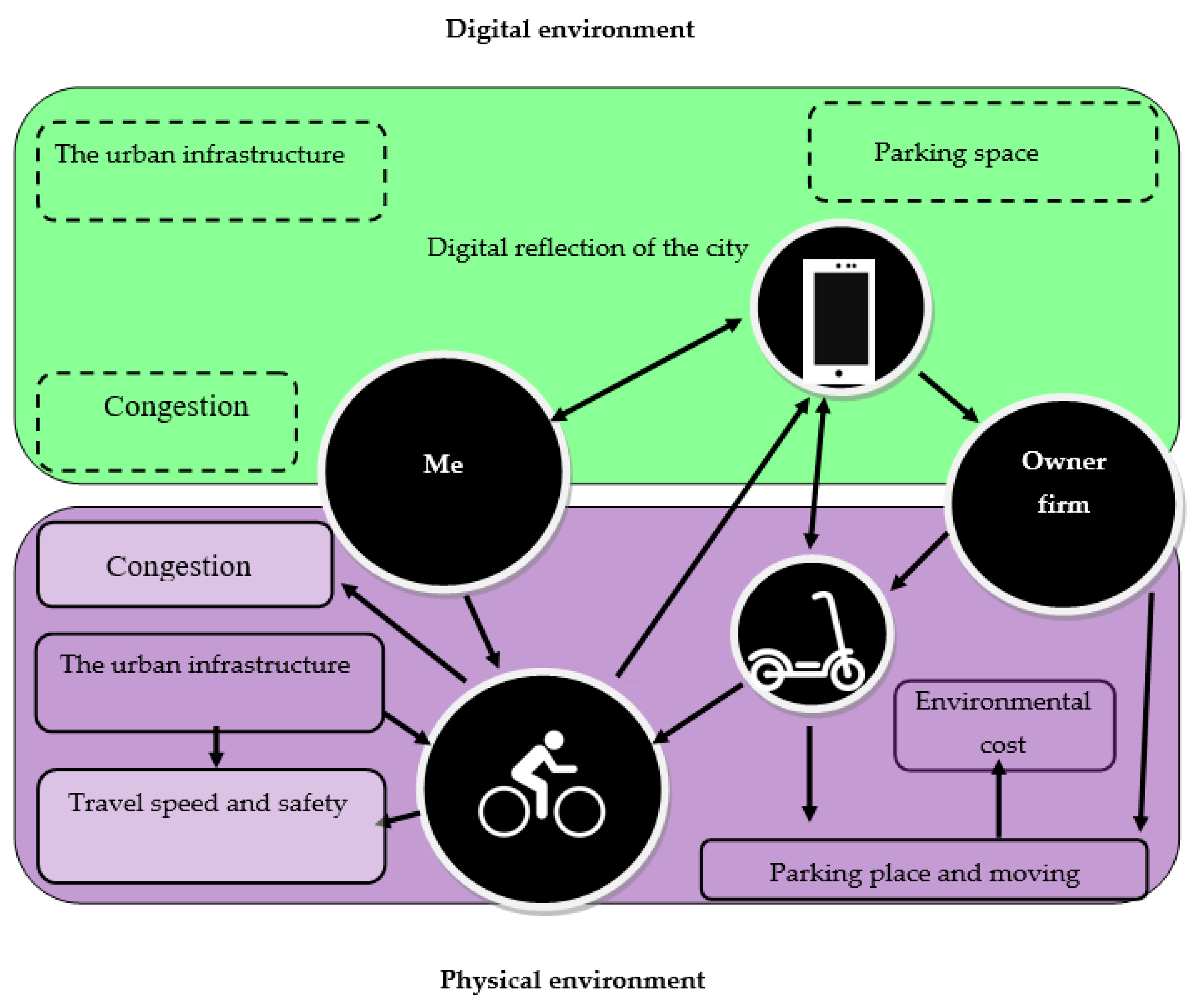
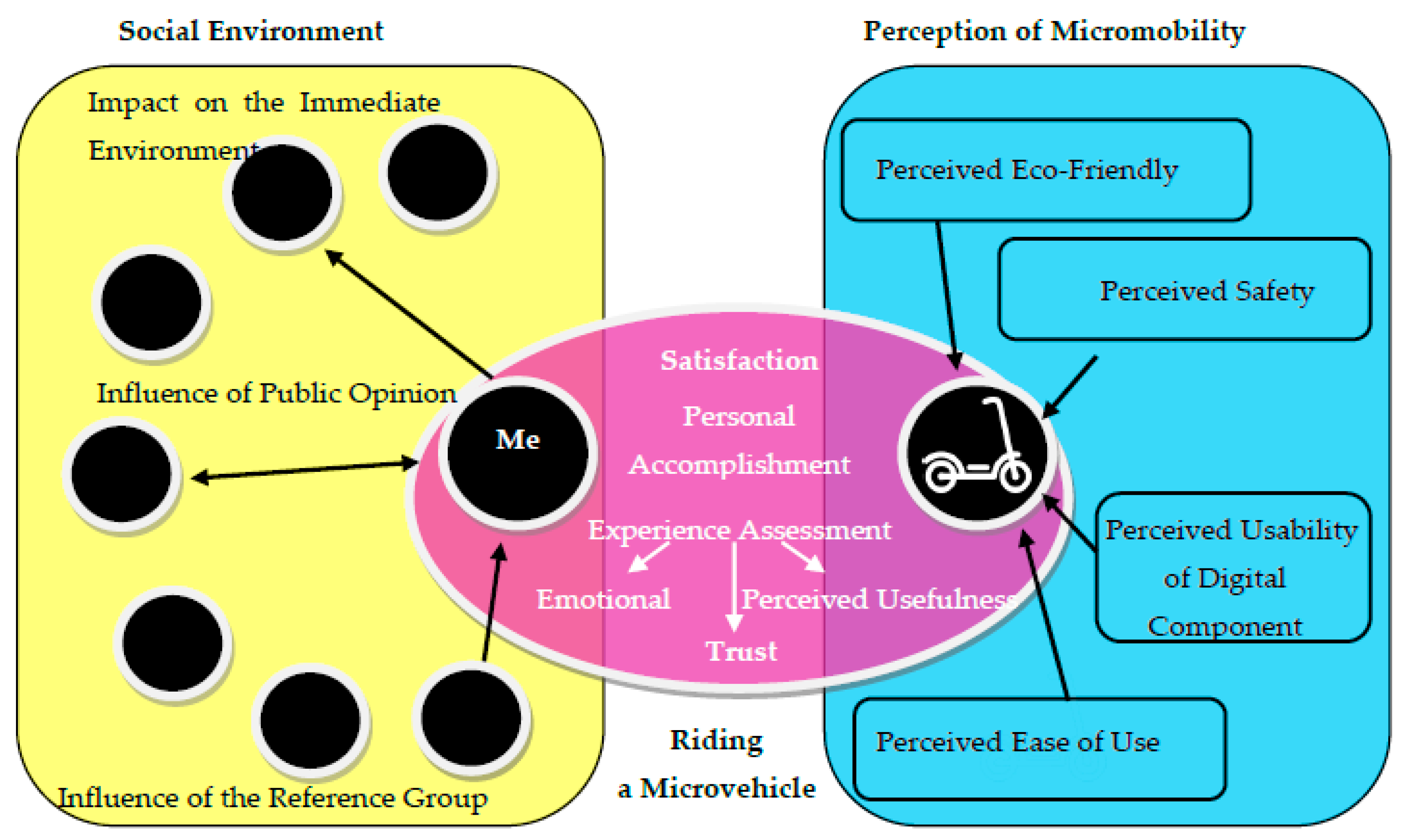
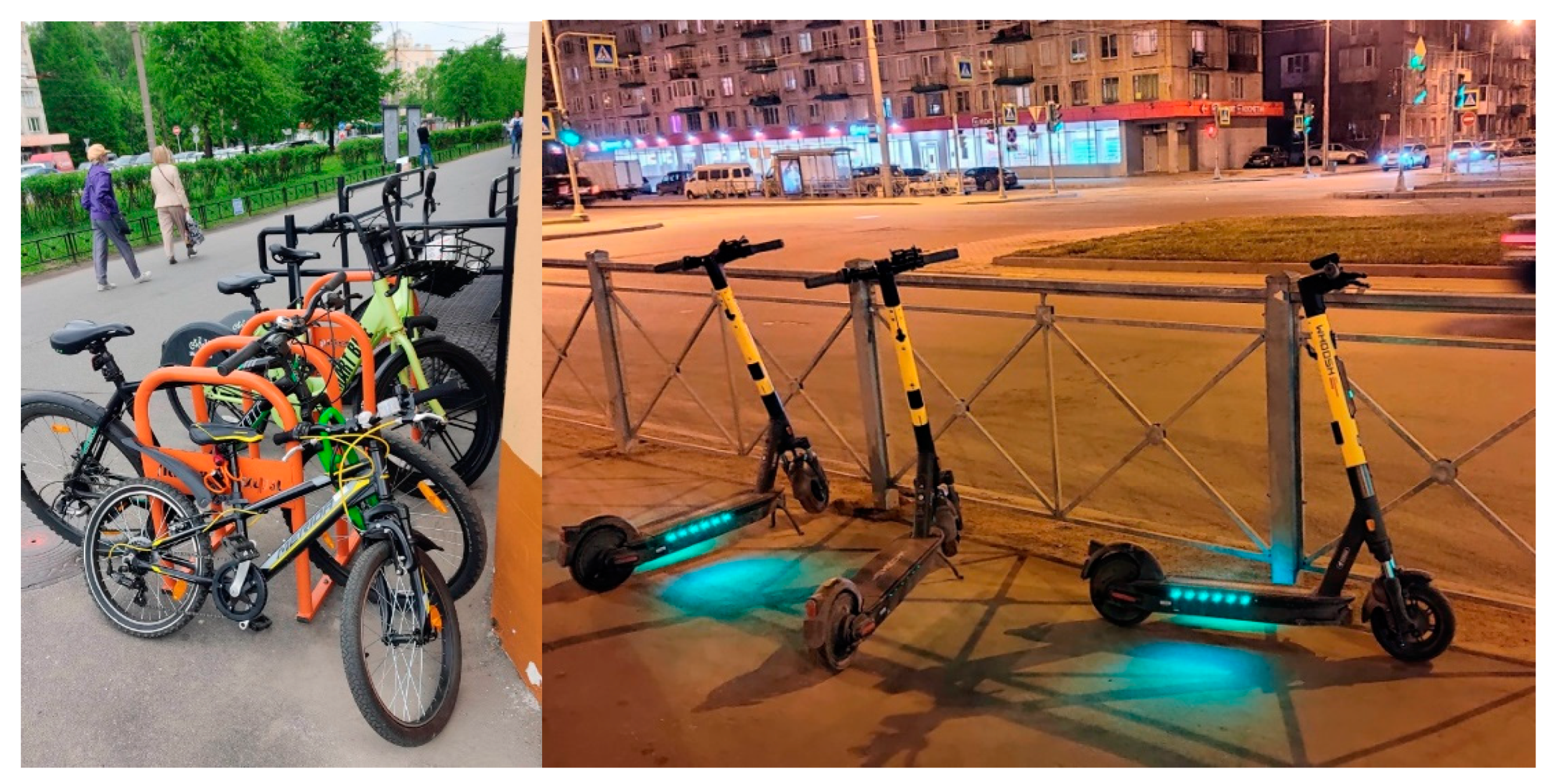
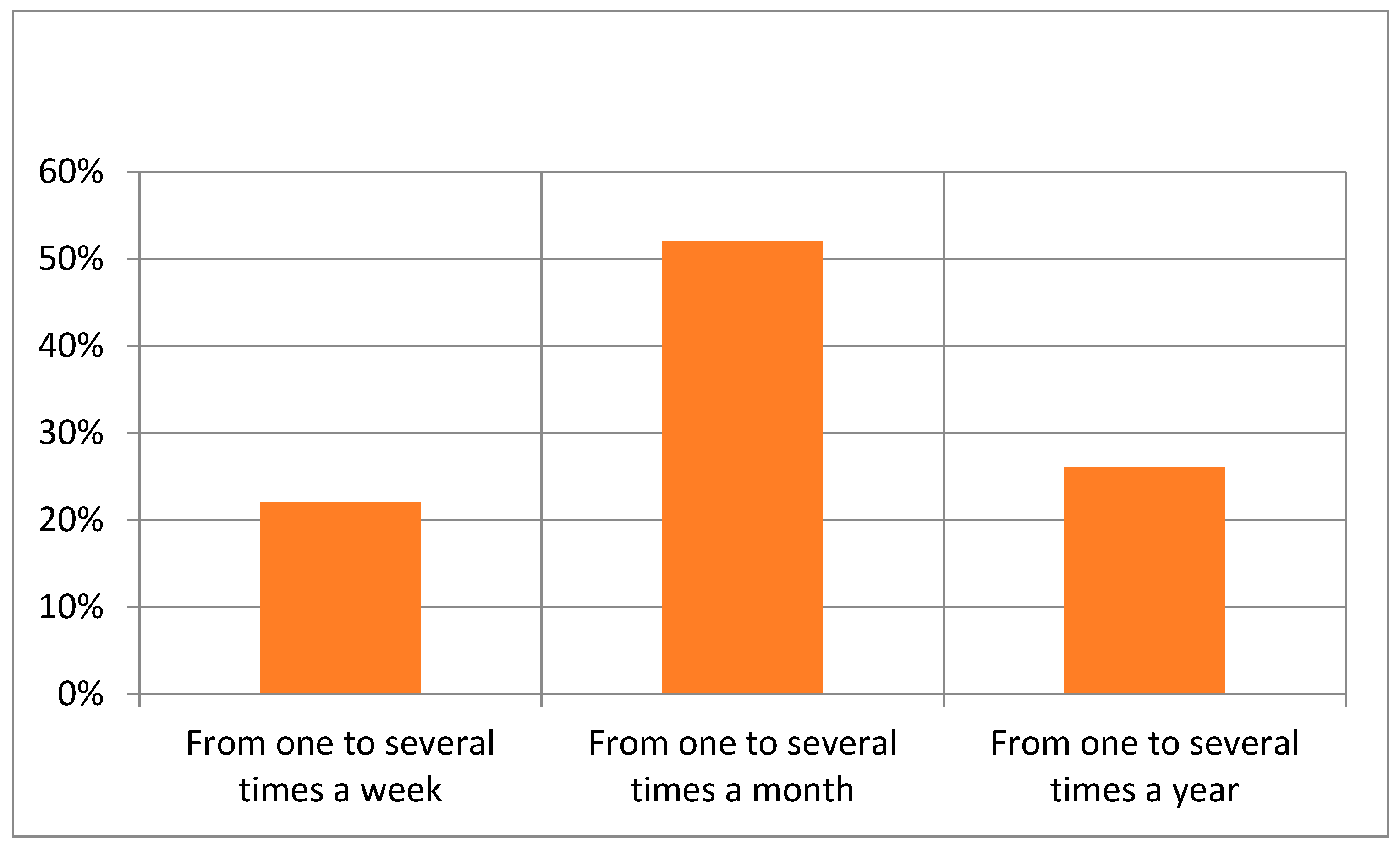
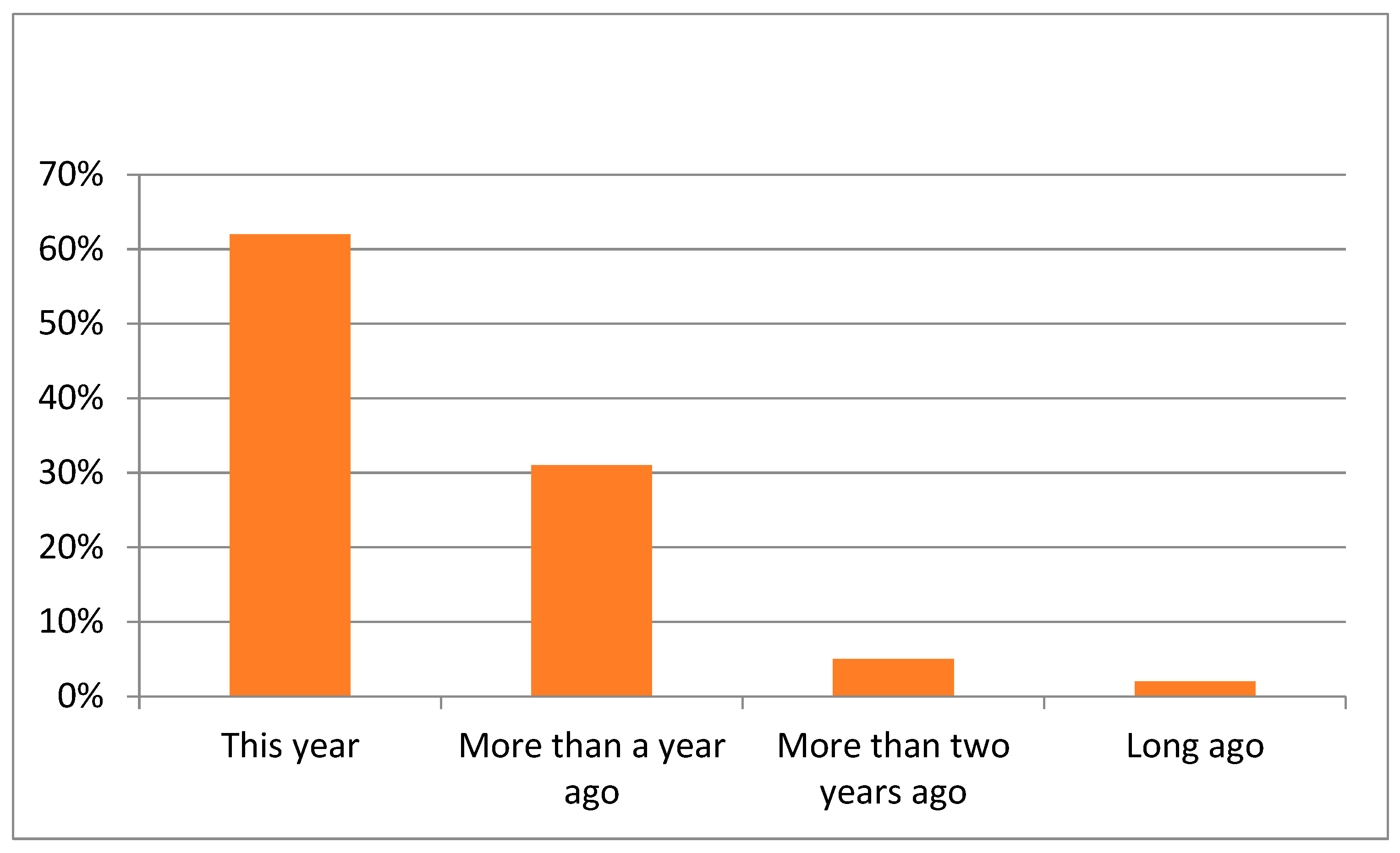
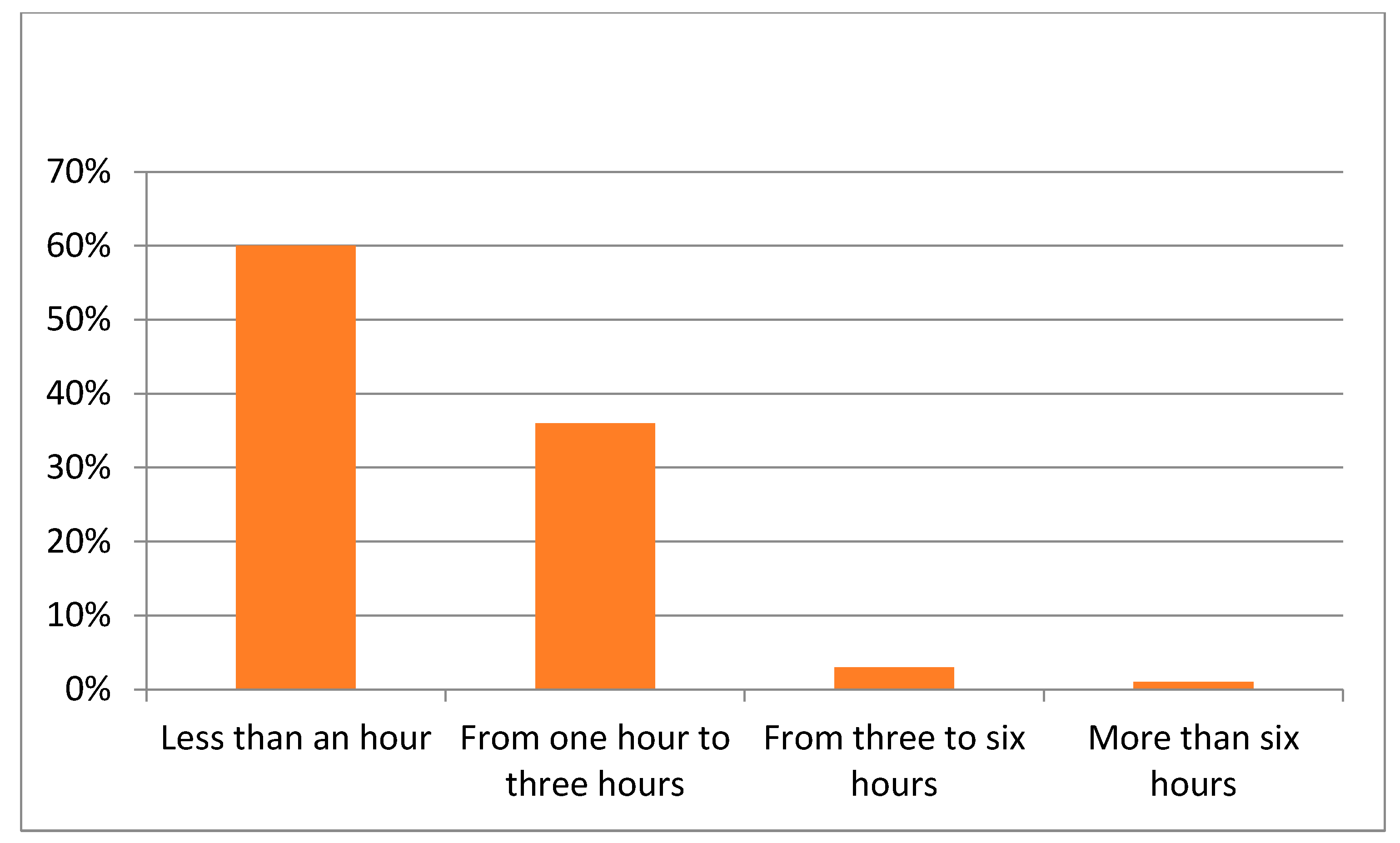
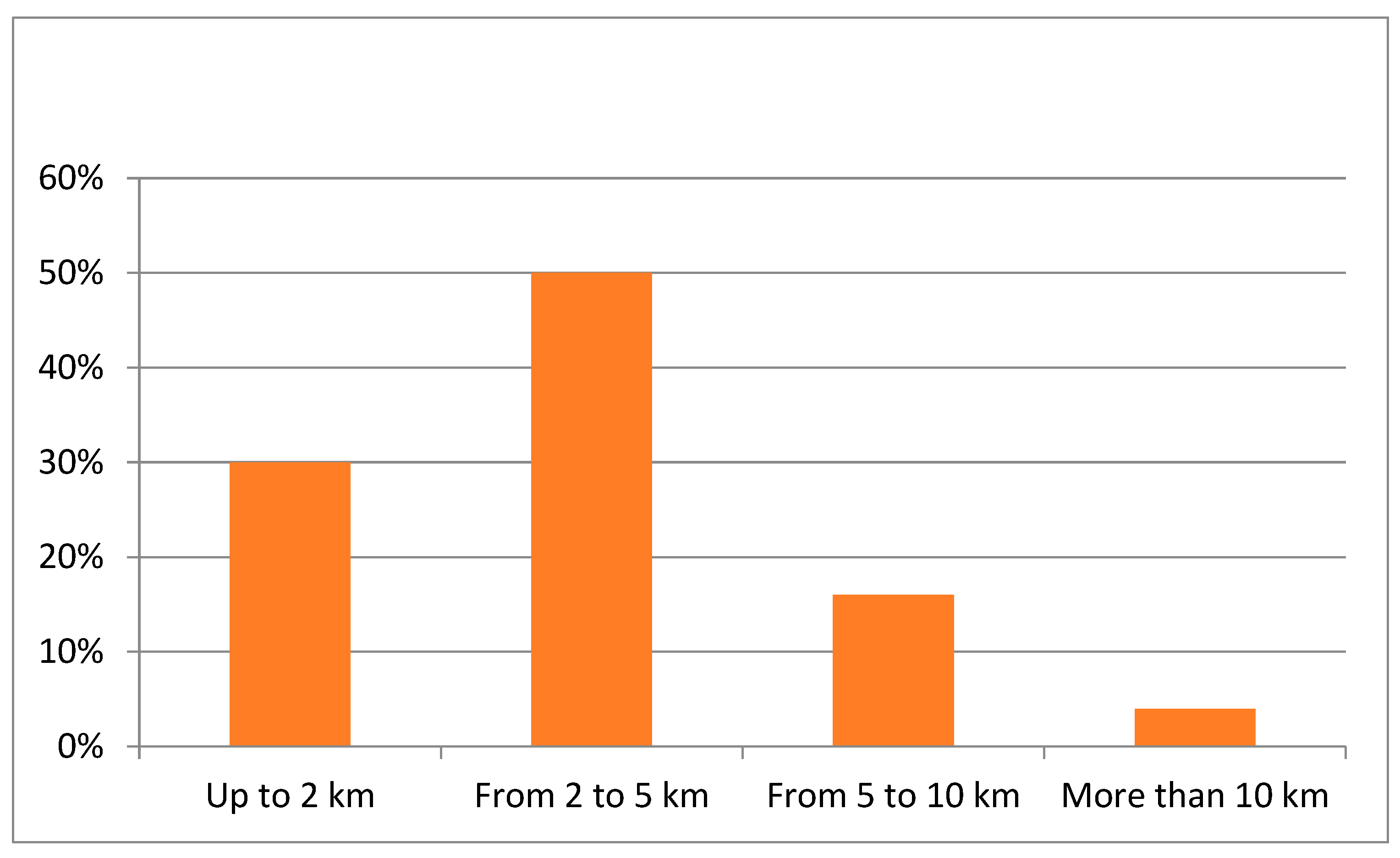
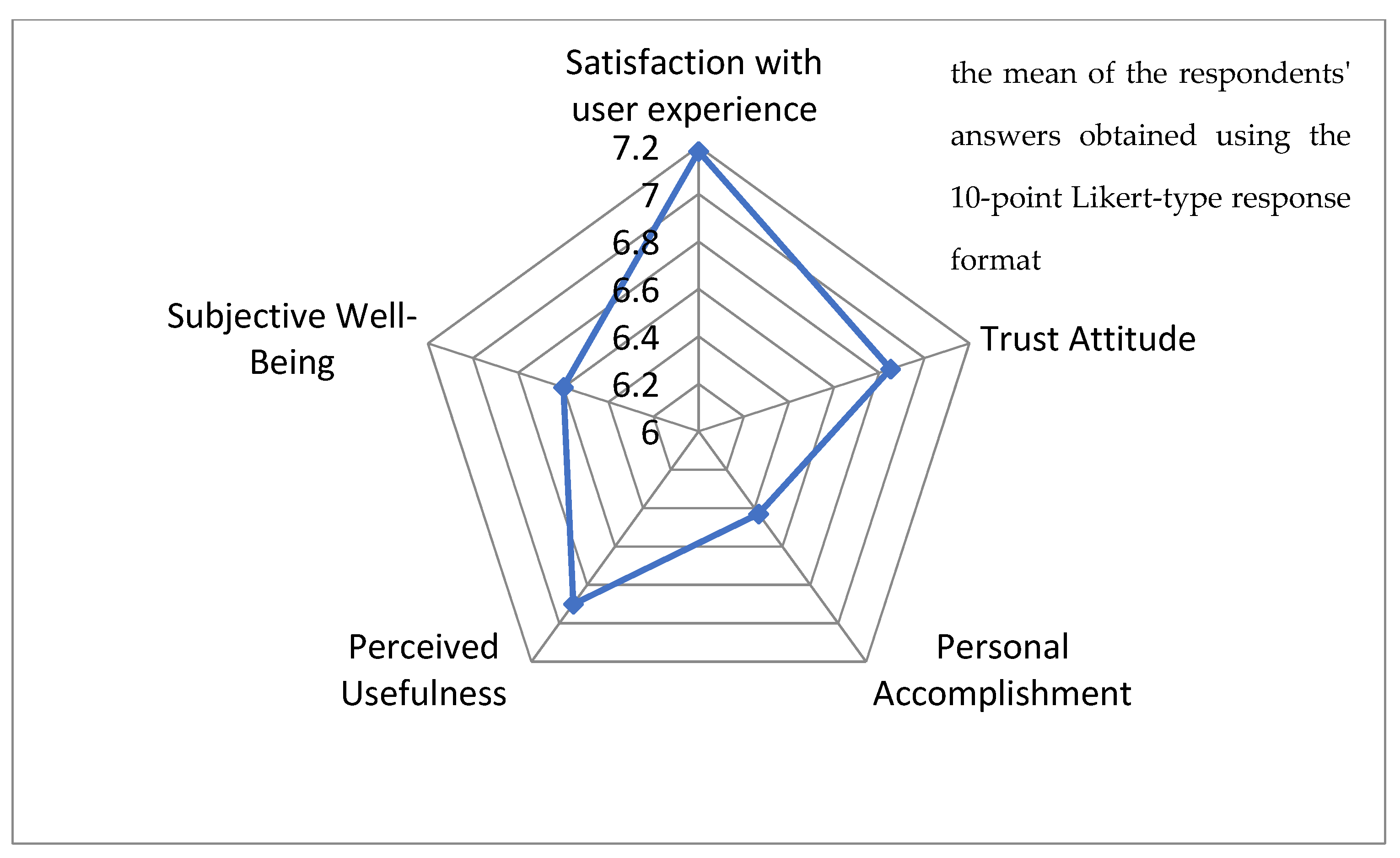
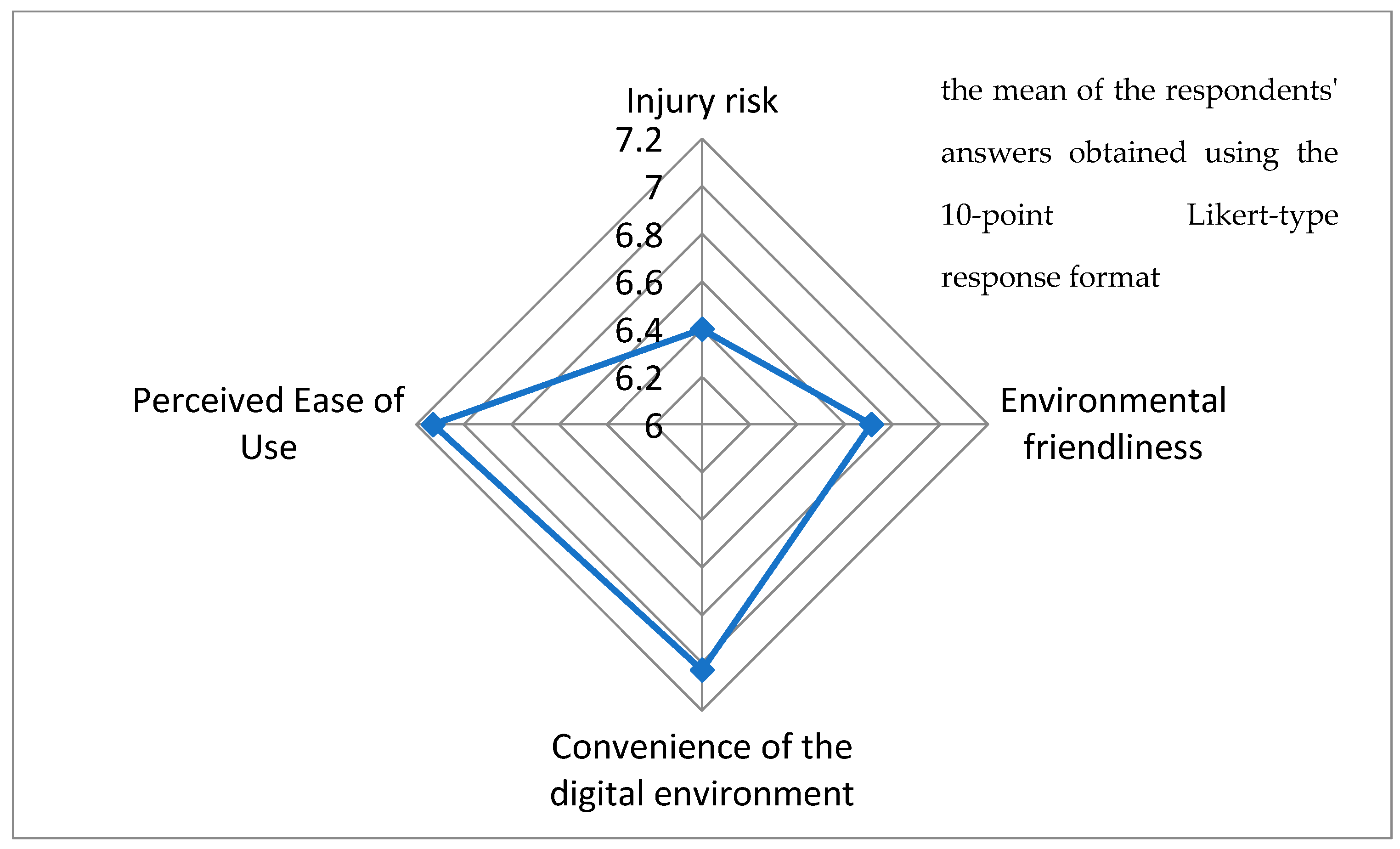
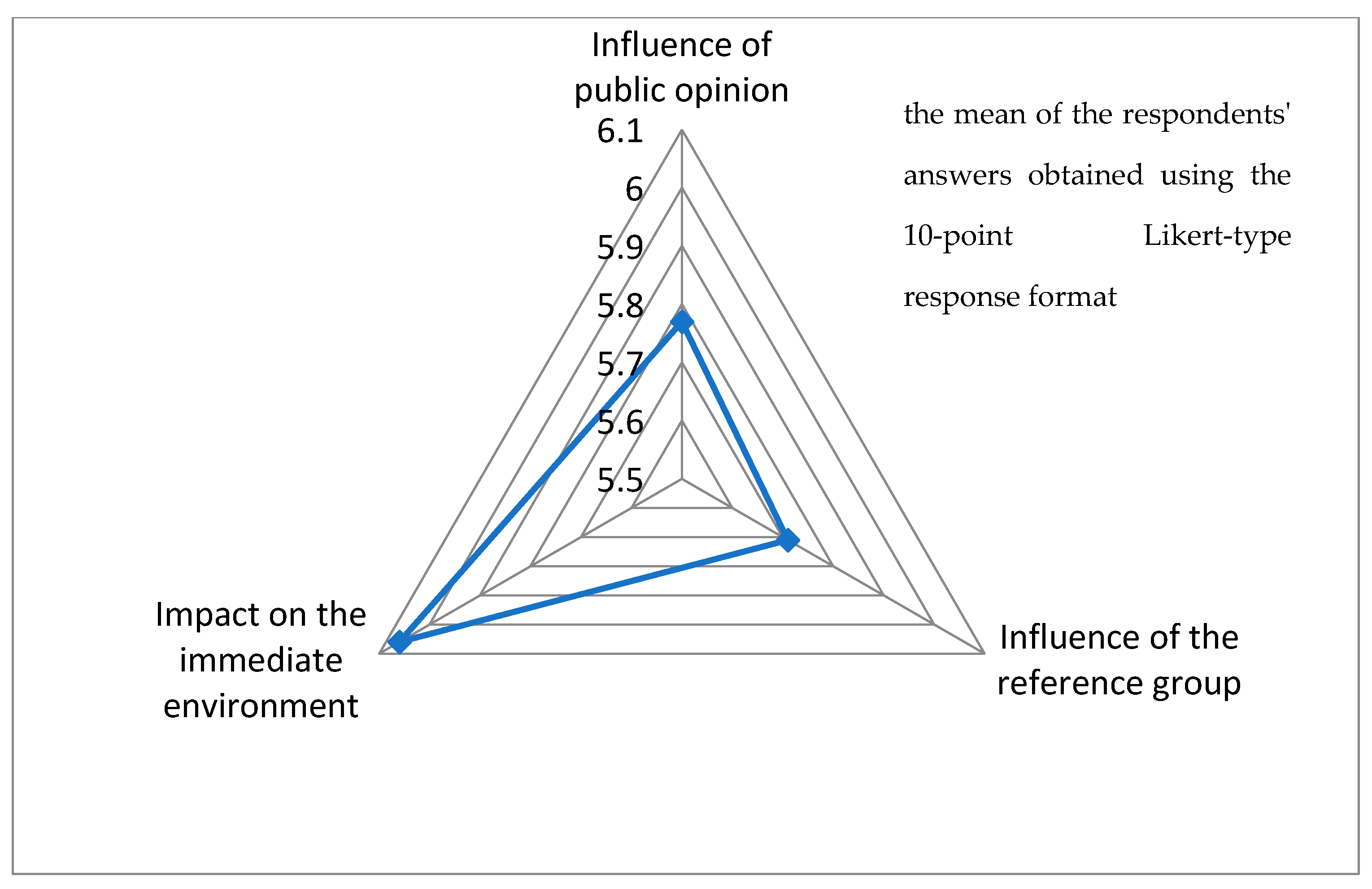
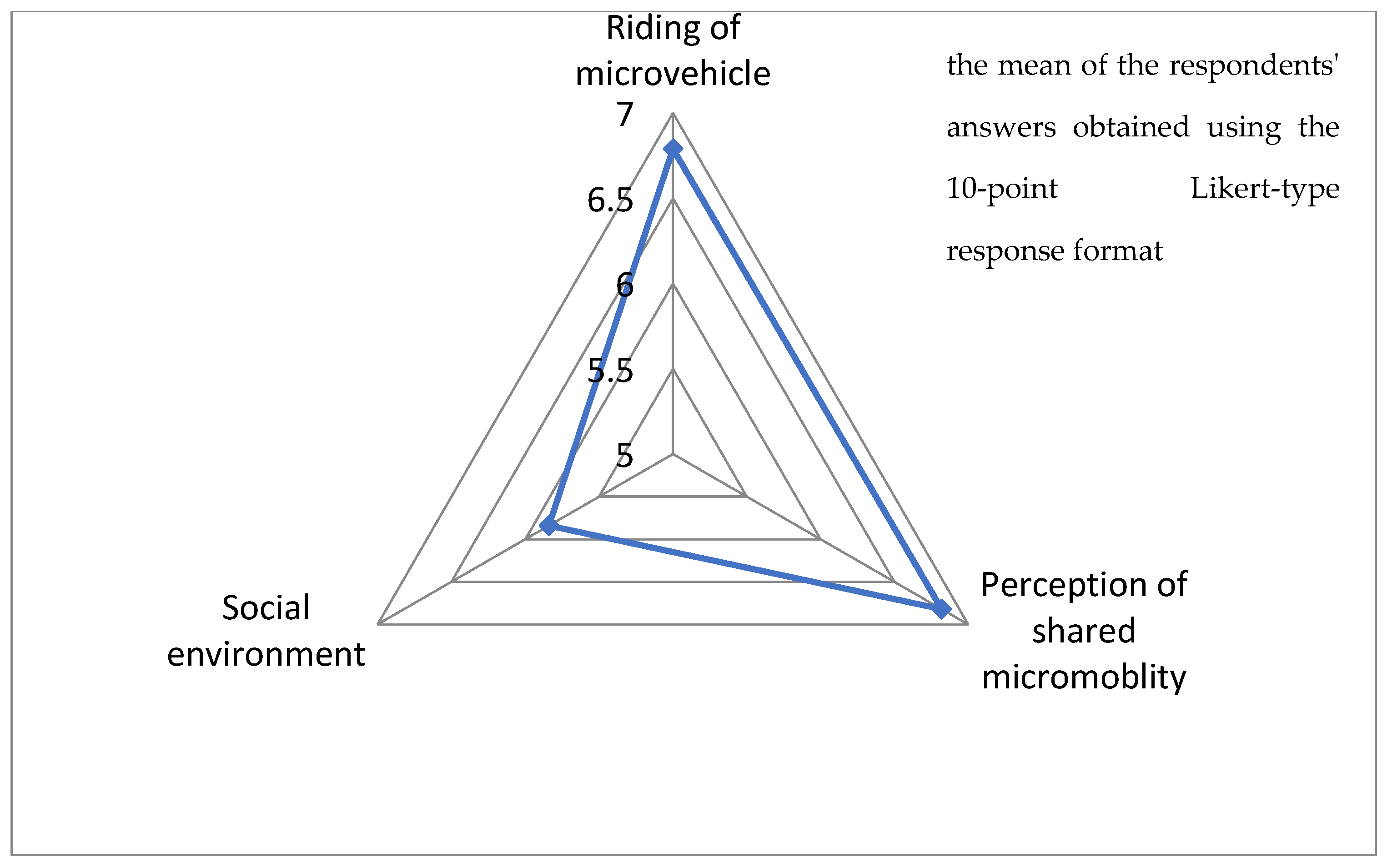
| Profiles | Description | Percentage (%) |
|---|---|---|
| Gender (Male/Female) | Male | 60.1 |
| Female | 39.9 | |
| Age | 18–20 | 83.4 |
| 21–25 | 10.6 | |
| 26–30 | 1.4 | |
| 30–40 | 1.1 | |
| more than 40 | 3.5 |
| Average | Minimum | Maximum | Scope | Variance | Alf Cronbach | Number of Points |
|---|---|---|---|---|---|---|
| 6.772 | 5.829 | 7.363 | 1.263 | 0.212 | 0.981 | 17 |
| Average | Minimum | Maximum | Scope | Variance | Alf Cronbach | Number of Points |
|---|---|---|---|---|---|---|
| 7.000 | 6.402 | 7.504 | 1.102 | 0.131 | 0.958 | 12 |
| Average | Minimum | Maximum | Scope | Variance | Alf Cronbach | Number of Points |
|---|---|---|---|---|---|---|
| 5.785 | 5.271 | 6.341 | 1.071 | 0.158 | 0.963 | 9 |
| Trust Attitude | Personal Accomplishment | Perceived Usefulness | Subjective Well-Being | Injury Risk | Environmental Friendliness | Convenience of the Digital Environment | Perceived Ease of Use | Influence of Public Opinion | Influence of the Reference Group | Impact on the Immediate Environment | |
|---|---|---|---|---|---|---|---|---|---|---|---|
| Satisfaction with User Experience | 0.969 ** | 0.890 ** | 0.977 ** | 0.953 ** | 0.906 ** | 0.954 ** | 0.972 ** | 0.969 ** | 0.878 ** | 0.898 ** | 0.915 ** |
| Trust Attitude | 0.903 ** | 0.964 ** | 0.958 ** | 0.882 ** | 0.955 ** | 0.954 ** | 0.963 ** | 0.893 ** | 0.907 ** | 0.925 ** | |
| Personal Accomplishment | 0.896 ** | 0.919 ** | 0.811 ** | 0.905 ** | 0.875 ** | 0.865 ** | 0.903 ** | 0.908 ** | 0.906 ** | ||
| Perceived Usefulness | 0.961 ** | 0.886 ** | 0.959 ** | 0.962 ** | 0.959 ** | 0.897 ** | 0.915 ** | 0.926 ** | |||
| Subjective Well-Being | 0.869 ** | 0.955 ** | 0.932 ** | 0.932 ** | 0.922 ** | 0.941 ** | 0.951 ** | ||||
| Injury Risk | 0.867 ** | 0.908 ** | 0.891 ** | 0.801 ** | 0.830 ** | 0.835 ** | |||||
| Environmental Friendliness | 0.937 ** | 0.935 ** | 0.922 ** | 0.936 ** | 0.944 ** | ||||||
| Convenience of the Digital Environment | 0.962 ** | 0.854 ** | 0.871 ** | 0.888 ** | |||||||
| Perceived Ease of Use | 0.861 ** | 0.880 ** | 0.898 ** | ||||||||
| Influence of public opinion | 0.945 ** | 0.915 ** | |||||||||
| Influence of the reference group | 0.941 ** |
Publisher’s Note: MDPI stays neutral with regard to jurisdictional claims in published maps and institutional affiliations. |
© 2022 by the authors. Licensee MDPI, Basel, Switzerland. This article is an open access article distributed under the terms and conditions of the Creative Commons Attribution (CC BY) license (https://creativecommons.org/licenses/by/4.0/).
Share and Cite
Bylieva, D.; Lobatyuk, V.; Shestakova, I. Shared Micromobility: Between Physical and Digital Reality. Sustainability 2022, 14, 2467. https://doi.org/10.3390/su14042467
Bylieva D, Lobatyuk V, Shestakova I. Shared Micromobility: Between Physical and Digital Reality. Sustainability. 2022; 14(4):2467. https://doi.org/10.3390/su14042467
Chicago/Turabian StyleBylieva, Daria, Victoria Lobatyuk, and Irina Shestakova. 2022. "Shared Micromobility: Between Physical and Digital Reality" Sustainability 14, no. 4: 2467. https://doi.org/10.3390/su14042467
APA StyleBylieva, D., Lobatyuk, V., & Shestakova, I. (2022). Shared Micromobility: Between Physical and Digital Reality. Sustainability, 14(4), 2467. https://doi.org/10.3390/su14042467








